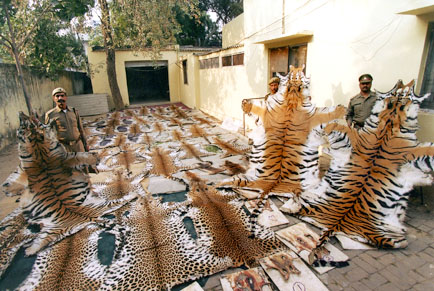Tigers are the world’s largest cats; a powerful and solitary predator at the top of the food chain that once roamed widely throughout Asia. For over a million years “The King of the Jungle” ruled over territories stretching from eastern Turkey to Far East Russia, with its home extending north to Siberia and south to Bali. At the beginning of the last century,
Bali Tiger
Bali Tiger
By the end of the last century, three of the nine tiger subspecies have been extinct, the Bali, Javan, and Caspian. Tragically, the remaining six, risk the same fate because of illegal wild life trade, poaching, loss of habitat, and conflict with people. Poaching is one of the bigger threats to the tiger’s survival where illegally, the tigers are hunted and killed for their fur, bones, and body parts then sold on the black market.
(Poaching)
The World Wildlife Fund (WWF) has continuously supported the endangered tigers, especially this year, 2010, “The Year of the Tiger”. WWF’s Tx2 campaign aims to put in place the necessary conditions to double the wild tiger population by the next Year of the Tiger in 2022. Tx2 seeks both immediate emergency measures to save the tiger, as well as a long-term foundation for securing the future of this beautiful animal. Throughout this year and for the remainder of the year, WWF had/is focussing their efforts on:
·
· Securing political will and action to double wild tiger numbers
· Protecting tiger habitat at an unprecedented scale, including clamping down hard on the illegal trade
· Engaging local communities and other relevant stakeholders as conservation stewards by providing economic and livelihood incentive.

 Aside from Tx2 campaign, WWF has created a campaign called “ROAAAR”. In the next few months the Heads of Government from the 13 countries that still have wild Tigers in their forests will come together for an historic meeting(around February 2011): The Tiger Summit. It is at this meeting where possibly the best chance to secure the tiger's long-term survival will be decided. To encourage these powerful people to make the right decisions and keep to their stated goal of doubling the number of wild tigers by 2022, WWF asks us to ROAAAR, in any way we can; by submitting a video, picture, or even a simple text message. Everyone who submits a Roar will be counted in a petition that will be taken to the Heads of Government when they meet.
Aside from Tx2 campaign, WWF has created a campaign called “ROAAAR”. In the next few months the Heads of Government from the 13 countries that still have wild Tigers in their forests will come together for an historic meeting(around February 2011): The Tiger Summit. It is at this meeting where possibly the best chance to secure the tiger's long-term survival will be decided. To encourage these powerful people to make the right decisions and keep to their stated goal of doubling the number of wild tigers by 2022, WWF asks us to ROAAAR, in any way we can; by submitting a video, picture, or even a simple text message. Everyone who submits a Roar will be counted in a petition that will be taken to the Heads of Government when they meet. Javan Tiger
Why save the tigers? How important can they be? This animal may be feared, but it is also revered and admired by people all over the world at the same time. By saving this species we are essentially saving many other endangered species that roam in the same 

Caspian Tiger
References
"Tiger Extinction." Essortment Articles: Free Online Articles on Health, Science, Education & More.. Web. 06 Oct. 2010. <http://www.essortment.com/all/tigerextinction_rxcy.htm>.
THE TIGER FOUNDATION. Web. 05 Oct. 2010. <http://www.tigers.ca/home/index.php>.
"WWF - Tiger - Overview." World Wildlife Fund - Wildlife Conservation, Endangered Species Conservation. Web. 06 Oct. 2010. <http://www.worldwildlife.org/species/finder/tigers/index.html>.
"WWF - What WWF Is Doing for Tigers." WWF - WWF. Web. 06 Oct. 2010. <http://wwf.panda.org/what_we_do/endangered_species/tigers/tiger_initiative/>.
"WWF - Why Should We save Tigers?" WWF - WWF. Web. 06 Oct. 2010. <http://wwf.panda.org/what_we_do/endangered_species/tigers/tiger_initiative/whysavetiger/>.
PHOTOS
http://travel.bf-1.com/wp-content/uploads/2010/01/bali-tiger.jpg
https://blogger.googleusercontent.com/img/b/R29vZ2xl/AVvXsEh5AlOQVxSN54ZchQX4EKaxHwZ9b4mRCMb_CQaWsheL5ToLbwTZGgtMwkVBrhtTKcZXhCmBEwfmm0BQRls9TqbjPPjWh4daEDCzt35R4MZDCHjLZHmQ77VerqnlLGWnVGQkp0tJnpl7I334/s320/3506.jpg http://www.juesatta.com/wp-content/uploads/2010/02/tiger01.jpg
http://www.solarnavigator.net/animal_kingdom/animal_images/Tiger_tigris_sumatran_subspecies_panthera.jpg
https://blogger.googleusercontent.com/img/b/R29vZ2xl/AVvXsEh5AlOQVxSN54ZchQX4EKaxHwZ9b4mRCMb_CQaWsheL5ToLbwTZGgtMwkVBrhtTKcZXhCmBEwfmm0BQRls9TqbjPPjWh4daEDCzt35R4MZDCHjLZHmQ77VerqnlLGWnVGQkp0tJnpl7I334/s320/3506.jpg http://www.juesatta.com/wp-content/uploads/2010/02/tiger01.jpg
http://www.solarnavigator.net/animal_kingdom/animal_images/Tiger_tigris_sumatran_subspecies_panthera.jpg
I commented on:


Wow 3,200 tigers left... that's really sad. It's amazing how selfish some people are with poaching, that's gotta stop. I never knew that tigers were so important to the ecosystem, 100sq km of forest is a lot, and without a doubt the tigers would be missed if they were extinct. Excellent blog!
ReplyDeleteI agree, I believe that the drastic change in population is very saddening and illustrates how out of hand the hunting of these large cats is. I believe that the best way to preserve these animals is to have special conservation areas where they can roam free without fear of being hunted. I also found the second picture on your blog to posses that "Wow factor" which really captivated me and kept me reading. It also helps illustrate how much the hunting of these animals has gotten out of hand.
ReplyDeleteWhen I hear that there is only about 3,200 tigers left it feels really sad to hear. We grew up hearing so much about tigers and there role in the animal kingdom. If they were to become extinct, what would we tell our kids? I think the tiger summit is a great idea and the fact that 13 countries will have a part in it, just makes me that much confident that there is still hope for the future tigers. The whole killing for money idea is ridiculous and the laws need to be reinforced when it comes to killing a tiger for money. I must say that this is an excellent blog, full of knowledge and I did learn more about tigers and hopefully more people will see this and try to do something to stop it. Good job!
ReplyDelete